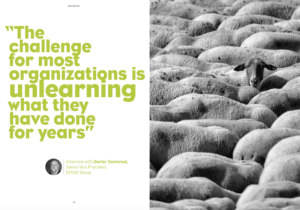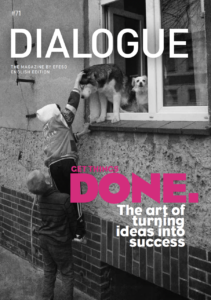 “The challenge for most organizations is unlearning what they have done for years”
“The challenge for most organizations is unlearning what they have done for years”
Interview with Dantar Oosterwal, Partner Idea-to-Value Practice from Issue #71 of Dialogue Magazine
What drives the innovation process, and where do we lose speed and performance?
The most important attributes are cadence and flow. Cadence corresponds to cycle time in manufacturing, while flow represents the time it takes for projects to be completed. When I speak with executives, they all know their production or service cadence. But when asked about innovation, they are often naive: “What is your innovation rate? What does your innovation flow look like? How does it support your business objectives?” These questions are usually difficult to answer.
Understanding the necessary innovation rate and aligning it with business needs is fundamental. We call this “cadence” because it is the metronome that keeps the entire organization in sync. If this cadence is missing, you find yourself in firefighting mode, constantly reacting to crises. Pushing forward major projects without setting a cadence and structured flow leads a company from one crisis to the next, trying to solve problems with increasing resources. Once a cadence is established, it becomes possible to introduce additional tools and determine which business goals need to be achieved through innovation. The concept of cadence is about understanding how many projects of which type, in which sequence, and at what speed are required to achieve revenue and profit targets.
Creativity and efficiency are often hard to reconcile. How should we handle this tension?
There are several aspects to consider. People want to be creative, but not when it comes to the process. I cannot imagine someone like Leonardo da Vinci randomly placing his paint differently every day. No, the colors were always in the same place on his palette.
The process must be standardized, it should be a tool that allows creative energy to be focused on the product. Once this mechanism is established, an extraordinary level of creativity can be unlocked. When I joined Harley-Davidson and took over Product Development & Product Planning, we made the mistake of investing as much creative energy into the process as we did into the product. In reality, the process should be predictable—almost boring.
Additionally, there needs to be a firewall between creativity and execution. If you only focus on the creative aspect, you will never bring anything to market. On the creative side of this wall, there must be a free flow of ideas, at least ten times more ideas than can actually be executed. On the execution side, cadence and flow take priority. You know your growth targets, understand how many projects of which type and in which sequence are needed, and pull the required number of ideas through this firewall. This is done based on lean development methodologies, project standards, and structured time and resource planning. In the end, you achieve both high efficiency and remarkable creativity. This is what we see at Apple, every year, they release a new product at the same time, defining their cadence. The same applies to other innovative and successful companies and is what we implemented at Harley-Davidson.
Can you explain how you arrived at this approach?
When I started at Harley, we struggled to complete projects and wasted a lot of creative energy on the process. This changed when we began working with the system dynamics team at MIT. For four years, every summer during our product launches, PhD students analyzed our development portfolio and processes.
Over time, we built system dynamics models of our development system and market launches, which helped us identify why projects were delayed and ineffective. I then had the privilege of working with Dr. Allen Ward, who specialized in lean development techniques. Together, we found solutions for the issues revealed by our models and laid the foundation for lean product development. Ultimately, we were able to unlock the team’s creative energy while aligning cadence at the firewall, just like in a factory. This resulted in a constant flow of great ideas and a healthy competitive environment on the creative side, as we had far more ideas in the pipeline than we could execute. This process, called the vortex, allows ideas to evolve and connect in new ways.
What does this approach mean for leadership?
Leaders need to understand how the innovation process impacts company performance and objectives, just as they do in production. The innovation process must be structured; otherwise, it becomes a chaotic stream of ideas. Management must establish the necessary mechanisms to control this process. Within the previously mentioned vortex, we use a method called the Consumer Technology Matrix. This helps leadership define strategic goals, align ideation with these objectives, ensure that idea generation remains customer-centric, and establish a structured feedback mechanism. This requires hard work, but it is also highly rewarding.
Can the increasing speed of trends lead product development in the wrong direction, or cause products to miss their market demand?
Of course, trends shift. But on the timescale, we are discussing, that’s usually not the real problem. The real issue lies elsewhere. When I joined Harley-Davidson, I wanted to understand what was not working. I analyzed the successful and unsuccessful projects from the past five years, and a clear pattern emerged. We often assume something is feasible or important to customers, commit to it, and later discover that we were wrong. Reviewing our history, I found that 90–95% of problems stemmed from this issue.
If you lack a connection to the business and customers do not have a structured feedback mechanism, you are in trouble. You start projects based on assumptions, only to realize they were incorrect later. For example, you might think customers want combustion engines, then assume they want electric motors, only to find out later they are not ready for them yet. When this happens, you are suddenly in firefighting mode, a crisis.
And firefighting mode is toxic for the entire organization. Without a clear cadence and a strong business connection, constant crisis management takes over. Many companies are permanently stuck in this cycle, making it their default development process.
How do you break free from this cycle?
There are four fundamental elements: Systems and processes to detect anomalies early. Once a cadence is established with standard projects, visual management tools can be used to identify issues. The ability to solve problems quickly and learn from them. In manufacturing, there is a predefined “help chain.” If an issue arises on the assembly line, a mechanism ensures that production resumes swiftly. Innovative companies use these problems as learning opportunities to refine their systems. Applying learnings consistently. Organizations should not face the same problem twice. Learning from past mistakes should be deeply embedded in the company’s culture. Leadership engagement. Many managers are disconnected from innovative processes and do not fully grasp their complexities. However, leaders can pinpoint issues and address them effectively by introducing cadence and structured systems. This final element is crucial. Leaders must lead and be effective in the process.
Are goals and KPIs useful in innovation processes, and how should they be set?
Goals and KPIs are critical, from strategic growth objectives down to process and idea flow management. Often, companies place innovation on the critical path without fully understanding the scope of the required innovation or the actual steps involved. I refer to this as false-positive feasibility. Deep, transformative innovations should not be rigidly planned without first addressing knowledge gaps. In product development, our primary task is to bridge the gap between what we know at the start of a project and what we must know to execute it.
Ironically, most companies fail precisely because they don’t ask the critical upfront questions: “How big is our knowledge gap? Can we close it within the planned timeframe?” Companies that adopt a set-based development approach— a key principle in lean methodologies—become progressively faster by accumulating and leveraging knowledge across multiple design decisions. This iterative learning process not only reduces rework but also accelerates innovation. That’s why we consistently shorten development time in every company we work with—often by more than half.
How difficult is it for companies to adopt this new perspective on innovation?
The biggest challenge is not learning a new approach but unlearning what has been done for years. If you are a CTO, you reached that position by doing things a certain way. When someone comes in and says, “We’re doing something completely different now,” it feels risky. At Harley, I had the advantage of system dynamics models, which clearly showed me what I was doing wrong and why I needed to adapt. That is why we focus on explaining the principles, the reasoning, and the methodology, and demonstrate them through pilot projects, leading to real transformation.
What is your vision for innovation in our fragile and dynamic world?
Today, we face numerous challenges, not only at the corporate level but also on national and societal levels, where we are constantly putting out fires. At every level, those who innovate the best, the fastest, and the most efficiently will be the ones who succeed. That is the key, that is what innovation can achieve.
I went into consulting because I feel it is my duty to help people understand the transformative power of innovation. I hope that more people will embrace these ideas and put them into practice because that is the only way forward.
Explore the Rest of Dialogue Magazine
